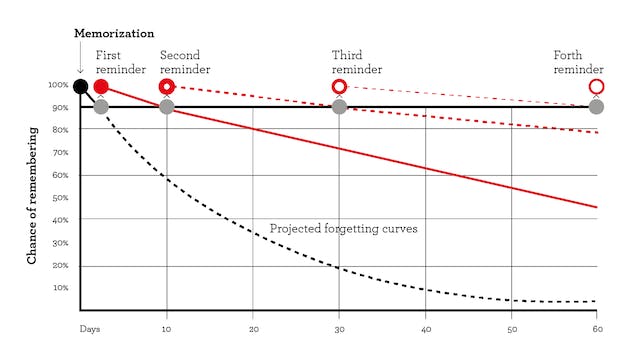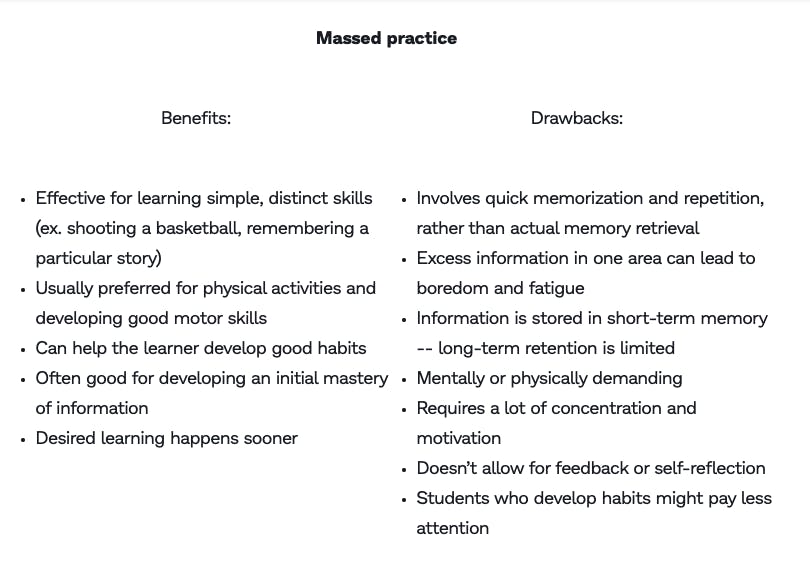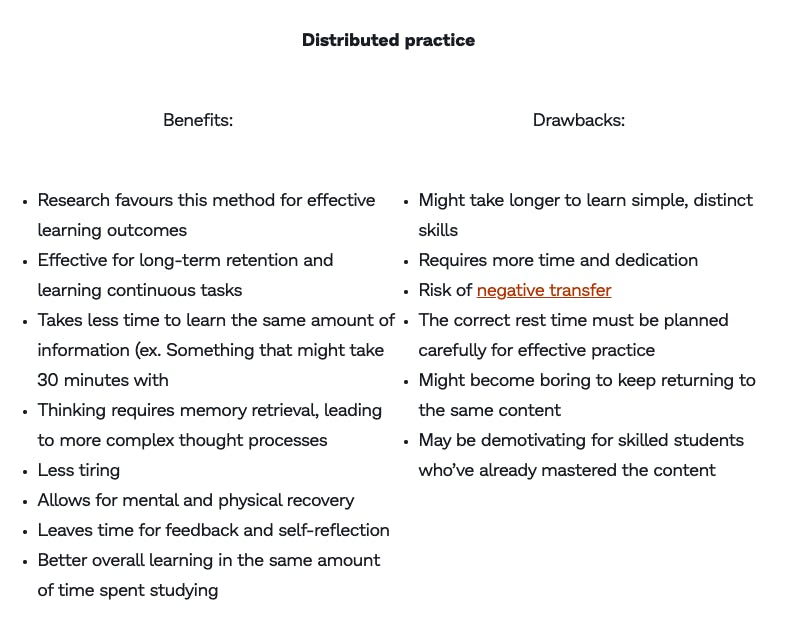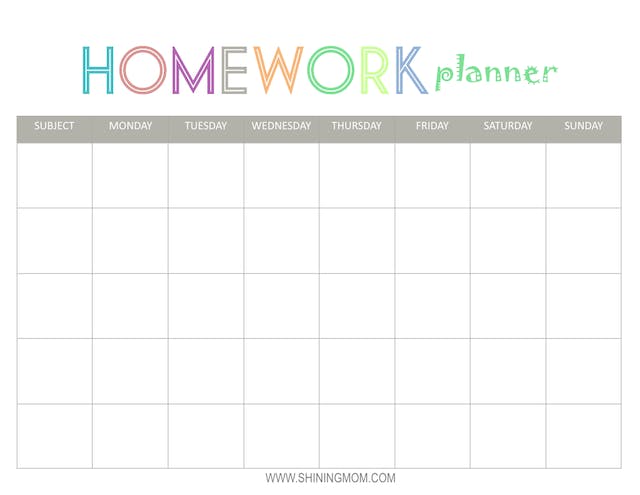7 Effective Ways to Use Distributed Practice at Your School
All Posts
Distributed practice definition
Distributed practice is a learning technique where practice occurs in multiple short sessions over a long period of time, with an acceptable amount of space between each session.
For example, studying something during two different sessions with a break of a few days (or even hours) in between, rather than learning it all in one go.
To qualify as distributed practice, each learning session must focus on the same subject.Teachers may prefer this alternative method instead of the more common, linear approach -- teaching content repeatedly in a short time, before introducing the next subject.
Distributed practice is a well-known theory in cognitive psychology that’s used in a wide range of disciplines, from improving memory to physical activity to music. And more recently, this practice has grown in popularity among academic educators.
The meaning of the term becomes quite clear when you split it up into its parts:
- Distributed = spread out
- Practice = to do something repeatedly so as to become proficient
The “spread out” aspect explains why distributed practice can also be referred to as spaced practice, spaced learning or spaced repetition.
How does distributed practice work?
Effective distributed practice in education follows four steps:
- Initial mastery -- Students are introduced to the material and achieve a baseline understanding of the topic.
- Spacing -- A considerable amount of time passes after the material is first learned.
- Retrieval -- Students must retrieve the previously learned information from memory during a new learning session.
- Repetition -- The process is repeated and material is re-learned over several sessions.
Essentially, the learning process looks like this:
Short term retention → spacing → retrieval → long term retention.
Think of this learning technique like sets of a workout. You need a break in between to gain the full benefits, reduce fatigue and develop important muscle groups or, in this case, skills.
But what does this break look like?
At this point, you’re probably asking one of the following questions:
Q: How long should the break be?
A: Experts say the optimal gap between learning sessions is about 10-30% of the retention interval-- the length of time you want students to remember the information.
For example, if you were preparing for a final test next month, the ideal spacing would be around 6 days. If it was something you wanted students to remember for 6 months, the ideal spacing would be around a month.
Q: How many learning sessions should there be?
A: This depends on a few factors:
- How much are you trying to learn or teach?
- How soon is the test or end of the learning period?
- What’s your overall goal?
Carefully answering these questions will help you come up with a reasonable plan that compliments what educators plan to teach. One subject might naturally demand more learning sessions than another, so it’s important to carefully consider the questions above.
Distributed practice will likely look different across subjects. School leaders must show teachers and students how to space practice for various subjects. And teachers must provide opportunities for both group spaced learning (in the classroom) and individual spaced learning (studying).
Retrieval practice
Retrieval practice and distributed practice go hand in hand. This learning strategy is based on the idea that consciously bringing information to mind boosts learning -- a necessary component for productive distributed practice.
Retrieval refers to information recall, using long-term memory to make connections and inform future learning. In other words, pulling knowledgeout oftheir minds and not just putting informationinto them.
In practical applications, it means formulating answers to a question -- not just reading or hearing it. This encourages students to dig into their memories for lessons they’ve already learned and helps create relevant connections and critical thinking skills.
The goal of retrieval practice is to improve learning. You want the retrieval to be challenging enough so it maximizes the benefit of long-term learning. If something takes a lot of effort to retrieve, it doesn't mean you didn't learn enough... it means you’re currently learning!
Teachers can use many methods in the classroom for retrieval practice, including tests and quizzes, practice problems, and writing assignments.
One UK teacher proposed the following method for regular quizzes that involve retrieval and distributed practice:
My quizzes now appear something like this:
Q1 – Q3 – retrieve key knowledge from last lesson.
Q4 – retrieve key knowledge from last week.
Q5 – retrieve key knowledge from last term.
Q6 – retrieve key knowledge from last lesson and connect it to knowledge from last term.
Research-backed benefits of distributed practice
Repetition is more effective when it’s spaced. Studying one piece of information at different times will benefit learning much more than studying all at one time, for longer.
During a study on elementary school children, students were tested on different learning schedules. Results showed that the best performance across the board happened when distributed learning was applied.
Unsurprisingly, Another study on undergraduate students found similar results. Students who reviewed class notes one week after initial learning did better by one half-letter grade on a final test, compared to students who reviewed their notes one day after initial learning.
The benefits of distributed practice can be found in a variety of areas: fact learning; problem solving; physical activity; music and more. The research in its favor is undeniable.
Wondering why?
The psychology behind distributed practice is known as the spacing effect: spaced reviews of the same information are better than repeated reviews in a short period of time.

A comparison of retention rates with and without the use of distributed practice. Source: Farnam Street There are a few reasons the spacing effect exists:
1. Priming
Priming means an initial exposure to a stimulus helps with later understanding.
The idea is similar to a priming coat of paint. The base layer makes the color go on much more easily. The same goes for learning!
When you increase the amount of practice, you get a priming effect for later learning events. This base knowledge makes learning easier in the following sessions.
2. Long-term memory consolidation
Traditional classroom learning (otherwise known as massed learning) usually only allows students to store information in short-term memory.
But when learning sessions are spaced and repeated, long-term memory is activated and learning can last longer. Students can then retrieve the information from their memories in the future.
3. Contextual differences
When learning sessions are broken up, the context surrounding them is different. Students might learn on a different day, in a different location, or from different media sources. They’ll probably receive a wide range of stimuli from different situations and encode them in their memories, associating them with what they’re learning.
Since context helps enable memory retrieval, involving more stimuli in distributed learning sessions increases contextual cues, especially since there’s more time between them. Providing more varied opportunities for memory recall helps create an environment for students to remember material better.
Note: Multimodal learning, the practice of teaching in various ways to stimulate different senses, can maximize this benefit.
4. Complex thinking
When students learn concepts through distributed practice, retrieval requires complex thought. When learning is distributed, enough time has passed that retrieval requires actual access to memory storage, not just short-term rehearsal.
Students also pay more attention when repetition is further apart, since they can’t just rely on the familiarity of something they recently learned.
5. Procedural memory
Repeating an activity enough can train your brain to automatically remember it. Eventually, you can perform certain tasks without conscious effort.
One of the most effective ways to increase the effectiveness of procedural memory is distributed practice. By spacing out learning opportunities, knowledge can become procedural.
Distributed practice requires repetition. Soon, students may be able to apply skills their procedural memories have saved from previous learning sessions.
Massed vs. distributed practice
Think back to the scenario we discussed at the beginning of this article. Teachers focusing on one unit at a time, students cramming for tests, and forgetting material.
That form of learning is called massed practice-- the polar opposite of distributive practice.
Massed practice comes down to cramming. It involves fewer, longer learning sessions with little to no rest in between. Reviews happen right after the original learning event and learning is generally more intense.
Advantages and disadvantages exist for both learning theories, though research seems to favor distributed practice.
Let’s explore some benefits and drawbacks of massed vs. distributed practice.


Whichever practice you use would largely depend on the desired outcome and how much learning there is to do.
In school settings, distributed practice is typically a smarter choice -- it helps students remember things they need to know all year long, so they can build upon prior knowledge.
7 Distributed practice strategies for your school
Now that you’re familiar with distributed practice as a theory, it’s time to take action!
Share these seven distributed practice examples and strategies with your teachers, so they can help students learn.
1. Study schedules and journals
Most kids have trouble regulating their schedules, especially when it comes to homework.
Luckily, you can overcome this by making study schedules and journals a necessary part of your curriculum.

Image source: Shining Mom
Schedules help students create time to study each day, so they can steadily gain all the important benefits of distributed practice.
Teachers should make sure their students follow these steps:
- Write down their current after school schedules on a calendar.
- Try to find time they can dedicate to studying each day, at least three days a week.
- Choose how long each session will be, based on how busy they are and/or how long they can be productive for. This could range from five minutes to multiple hours.
- Add their study times to the calendar
Once the calendar is complete, students can use study journals to log whether or not they succeeded, and adjust their calendars as necessary. Encourage students to do daily self-reflections, and encourage teachers to check in with their students on an ongoing basis.
At the beginning, it can be a hard commitment for kids. But even if they don’t stick to the them, having these schedules can help motivate them to practice more than they otherwise would have.
Note: Students should not be punished for not following their study schedules. This merely presents an opportunity to reflect and adjust.
2. Formative assessments
Encourage formative assessment strategies such as cumulative tests or frequent, low stakes quizzes to support regular check-ins and reflections.
Formative assessments require changes in study habits and make distributed practice essential, ultimately leading to better learning.
Teachers should begin each class with a review exercise or a small quiz -- preferably written, not multiple choice -- to encourage distributed practice and retrieval. The subsequent results can help teachers assess knowledge gaps and figure out where to focus future efforts.
Regular formative assessments help students secure items in memory and improve future knowledge recall.
3. Cumulative assignments
Distributive practice works best with cumulative, dynamic projects that include topics from multiple units.

An example of a final cumulative assignment that includes multiple components. Source: Teaching With a Mountain View
Homework requires students to retrieve what they learned earlier, creating additional layers of meaning in new material that connect to old material. This allows for greater retention and seamless distributed practice.
A math test could require written answers that connect back to an earlier English unit, or an art project could require knowledge of previous science units. The possibilities are endless, with many ways for teachers to extract the most meaning out of cumulative assignments.
Teachers might consider the following questions when creating cumulative assignments:
- How do the themes in your current novel relate to a previous book?
- What should students remember about a prior unit that would help them with the current one?
- What concepts overlap between given subjects?
- How can you build upon learnings with new information?
4. Let students sleep
“You snooze, you lose” may hold truth, but not when it comes to actual sleep.
Research on second language learners found students who slept between learning sessions had better long-term retention and needed half the practice, compared to those who spaced theirs over the course of a single day.
Sleep is incredibly important for learning -- and especially relevant for children, who naturally need more sleep during developmental years.

Image Source: Sleep Education
Memory consolidation happens during sleep, so students should never underestimate the importance of a good night’s rest between learning sessions. Even if two study sessions are the exact same, breaking them up with sleep should result in better learning outcomes.
To make sure students can get enough sleep, space out homework so there isn’t too much on a given night. A great way to accomplish this is with frequent small assignments or spacing out individual parts of a larger project -- both of which involve regular check-ins. And don’t forget -- study schedules and journals will help with this, too.
Adequate sleep will also boost student energy and make them more receptive to learning after they wake up. Students, teachers and parents will be more than happy with the results.
5. Delayed homework
This strategy involves staggered assignments, which involves teachers assigning homework on a particular topic a few weeks, or months, after they originally taught it.
o delay homework, teachers should do the following:
- Teach an initial learning session on a given subject or unit
- Create a homework assignment based on this
- Move on to teaching the next topic, or the next few topics
- Assign homework on the original topic
Regular delayed homework would mean students are constantly solving problems based on things they’ve already learned, but aren’t currently working on in class. These regular reviews mean constant memory retrieval, which is perfect for spaced learning.
6. Spaced curriculum
This strategy is by far the biggest undertaking, but it’s likely the most effective way to achieve true distributed practice.
Most schools teach curricula one unit at a time. Spaced curriculum means teaching the same material, but broken up and spaced throughout the year.
What does this look like?
Teaching numerous areas simultaneously while regularly visiting old topics. However, some educators are opposed to this strategy because it jumbles up the traditional linear teaching structure.
This strategy would involve huge amounts of planning and organization and would likely require a mandatory change at a school or district level, as it would completely rework current teaching methods.
Although it’s a big adjustment, taking any steps in this direction can greatly benefit your teachers and their students.
7. Prodigy
Teachers are often constrained for time and resources, and might not be able to make significant changes that encourage distributed practice. Technology is a great way to combat this -- teachers can rely on technology to distribute lessons for them.
Prodigy is an adaptive math platform used by 1st to 8th grade students around the world.
This engaging, curriculum-aligned game can be used for supplementing regular lessons, differentiation, formative assessments, and more. Teachers have the freedom to customize math content with its helpful Assessments tools. They can assign previously learned math skills and stagger practice after initial instruction.
How to use Prodigy Math for distributed practice
Prodigy is a powerful tool for distributed practice, as long as you know how to use its features effectively.
So, what are those features?
Here are three ways you can use Prodigy for distributed practice:
Distributed practice: final thoughts
Evidence confirms: distributed practice is an effective tool for learning -- and not just for tests. Teachers should incorporate spacing to all possible learning opportunities.
Keep in mind that the purpose of distributed practice is to improve learning. The goal is not to frustrate students or test their memories, but to strengthen cognitive processes and create a holistic educational experience that lasts a lifetime.
Use the above strategies to encourage distributed practice at your school, and you’ll soon see big strides in learning, long-term retention and student confidence.
Want to make distributed practice a reality at your school? Try Prodigy— the curriculum-aligned math platform used by more than 1.5 million teachers and school leaders. Teachers can use Prodigy to:
- Align in-game adventures with classroom lessons
- Collect insights into student progress and learning gaps
- Send differentiated content and Assessments in just a few clicks



